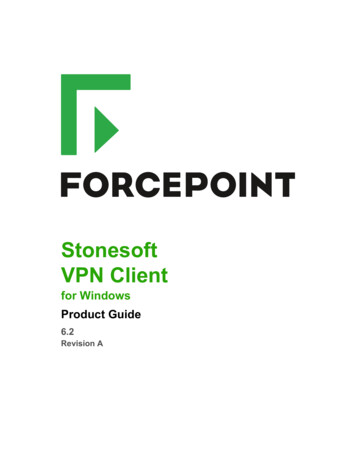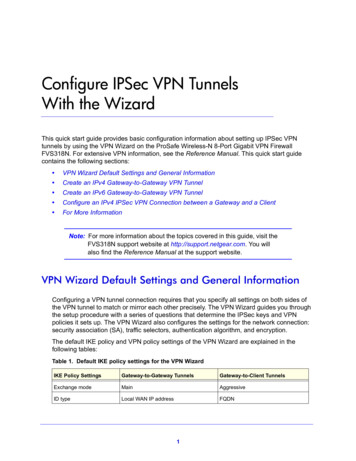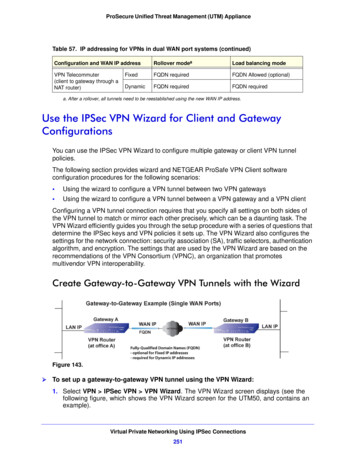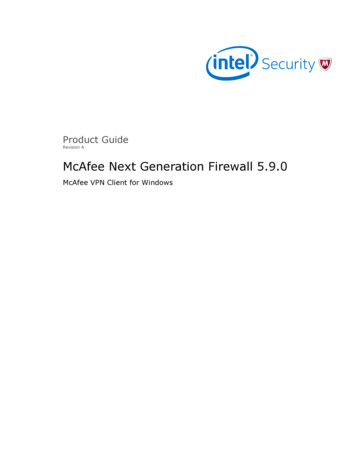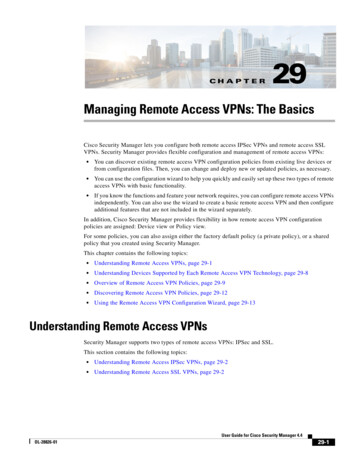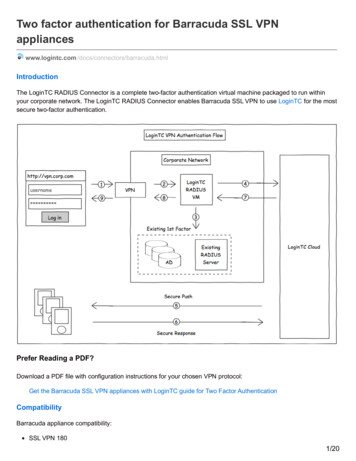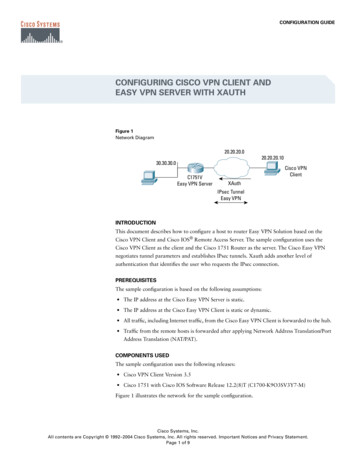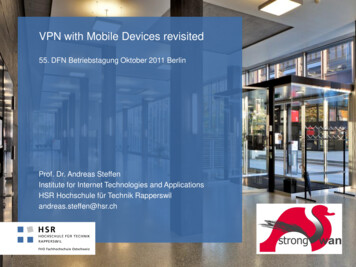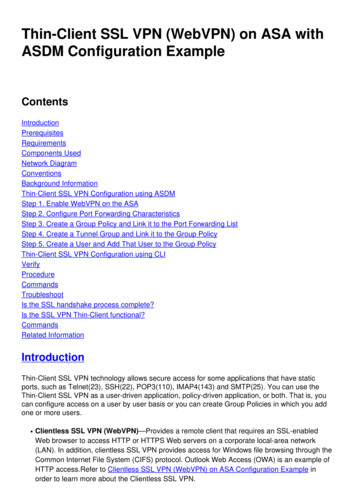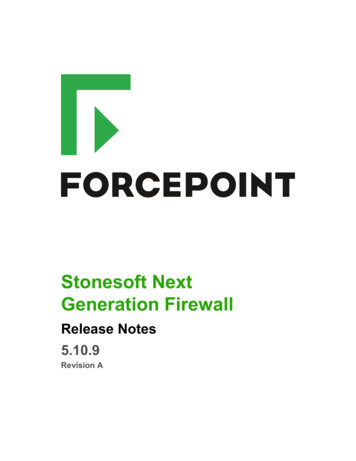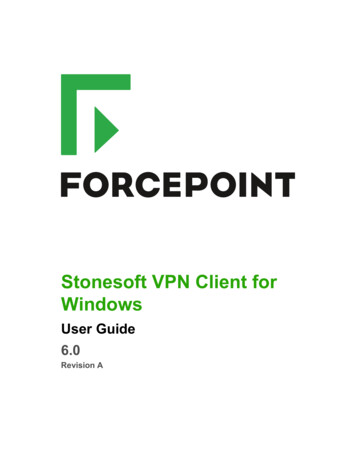
Transcription
Stonesoft VPN Client forWindowsUser Guide6.0Revision A
IntroductionThis guide provides end-user instructions for installing and using Stonesoft VPN Client.Stonesoft VPN Client is a software application that runs on your computer. The client allows you to connectto your organization's network from anywhere. Using a virtual private network (VPN) establishes a secure,encrypted connection that protects the information you transfer.Introduction 2
Installing and upgradingThe Stonesoft VPN Client can be added as a new installation or as an upgrade.Install the Stonesoft VPN ClientYour administrator provides the installation file.Check with your administrator about the installation process. Your administrator might be using a standardinstallation file or a preconfigured file.1.2.3.Double-click the installation executable file.The Stonesoft VPN Client Setup window opens.Click Install.The Stonesoft VPN Client Setup wizard opens.Click Next and follow the on-screen prompts.Note: You might see one or more confirmation requests during the installation. Allow theinstallation of all drivers and components.When the installation is complete, connect to a new gateway to start using the Stonesoft VPN Client.Related tasksConnecting to a new gateway on page 5Stonesoft VPN Client connects to a gateway, a device within your organization's network that is integratedwith the rest of the network. Connecting to a gateway for the first time requires a different process than laterconnections.Upgrade the Stonesoft VPN ClientWhen there is a new version of the Stonesoft VPN Client, you can upgrade the existing installation.1.Download the installation .exe file.Note: If you are not the administrator, the administrator supplies this file.2.3.4.5.6.Double-click the executable file.A confirmation message appears.Click Yes.The Welcome screen for the installation wizard opens.Click Next to start the upgrade.During the upgrade process, the earlier version of the Stonesoft VPN Client is removed and replaced withthe current version using the same settings.Accept the License Agreement and click Next to continue.When the upgrade is finished, click Finish to close the wizard.Installing and upgrading 3
Using the right-click menuYou have access to several commands and properties in the right-click menu of the Stonesoft VPN Client icon.The color of the Stonesoft VPN Client icon changes according to the status of the Stonesoft VPN Client. Theavailable menu commands change with the status of the VPN connection.Tip: View the status as text by holding the cursor over the Stonesoft VPN Client icon.Figure 1: Stonesoft VPN Client right-click menu in the system tray on the Windows taskbarTable 1: Stonesoft VPN Client right-click menu optionsOptionDefinitionPropertiesMore actions and status information.Connect to New GatewayAdds a gateway.Select GatewaySelect where you want to connect.ConnectUse Connect/Disconnect to open and close a VPN.Connect to End-PointSelect endpoint if the gateway has several endpoints.ReauthenticateReauthenticate when convenient (instead of waiting forthe authentication timeout).Disable VPNDisconnect the VPN and turn off the automatic VPNconnection trigger.ExitExit the Stonesoft VPN Client.More information and commands are available in the Stonesoft VPN Client Properties dialog box that opensthrough the right-click menu or by double-clicking the Stonesoft VPN Client icon.Related conceptsMonitoring VPN connections on page 17You can manage and monitor active VPN connections.Using the right-click menu 4
Connecting to a new gatewayStonesoft VPN Client connects to a gateway, a device within your organization's network that is integratedwith the rest of the network. Connecting to a gateway for the first time requires a different process than laterconnections.If the gateway requires certificate authentication, you cannot connect to the gateway until you have a validcertificate. Your administrator tells you if you must obtain a certificate.The VPN connection requires identity verification in two directions, known as mutual authentication. Certificate fingerprint — The first time the Stonesoft VPN Client connects to a gateway, the identity of thegateway is verified to the Stonesoft VPN Client with the certificate fingerprint.User authentication — User identity is authenticated each time you connect to a gateway.Note: Your administrator tells you what to use in your environment.After the installation, you cannot connect to gateways and endpoints until they are configured in the StonesoftVPN Client. The administrator might have preconfigured the gateways for you so that you can connect to themby selecting them in a list. Alternatively, you can get the gateway configuration from the administrator as a filethat has been added to the installation. The gateways are included in the client when you start using it. Theadministrator can also tell you which IP address of gateway you should use. You can then add the gatewaymanually in the VPN Client. If the Stonesoft VPN Client is configured to allow domain logon through the Windowslogon screen, only gateways that you have connected to at least once are available.Related tasksCheck the list of available gateways on page 5View the gateways that are already configured.Connect to a preconfigured gateway on page 6The administrator might have configured a gateway for you in the installation package.Add a gateway manually on page 7If you have not previously connected to the gateway and it has not been preconfigured for you, you can add itmanually.Managing certificates on page 12If you use certificates imported through the Stonesoft VPN Client, you can manage the imported certificatesdirectly in the Stonesoft VPN Client.Check the list of available gatewaysView the gateways that are already configured.1.2.In the system tray on the Windows taskbar, right-click the Stonesoft VPN Client icon, then select Properties.Click the Gateways tab. All configured gateways are listed in the table.Related tasksConnect to a preconfigured gateway on page 6The administrator might have configured a gateway for you in the installation package.Select the authentication method on page 11Connecting to a new gateway 5
A gateway might allow you to select how you want to authenticate.Connect to a preconfigured gatewayThe administrator might have configured a gateway for you in the installation package.Note: The administrator tells you if you need a certificate. If the gateway requires certificateauthentication, you must have a valid certificate to connect to the gateway.1.2.In the system tray on the Windows taskbar, right-click the Stonesoft VPN Client icon, then select an itemfrom the menu. No preconfigured gateways yet — Select Connect to New Gateway directly at the main level. Preconfigured gateway available — Select Select Gateway Connect to New Gateway.Make sure that Preconfigured Gateway is selected.Note: If the setting is disabled, add any new gateways manually.3.4.Select the preconfigured gateway.(Optional) Select the endpoint to connect to.Tip: Endpoints usually correspond to different Internet connections at the office.5.6.Select whether authentication is based on a manually entered user name and password or on the usercertificate.Your administrator tells you what to select.For IPsec VPN connections, click Advanced to define the settings.Note: Do not change the Advanced settings unless your network administrator specificallyinstructs you to.OptionDefinitionUse Limited CryptographyTrust CAs in Microsoft Certificate StoreCAUTION: Select this option only ifyour organization prohibits the use ofstrong cryptographic methods.Select this option to use the Microsoft CertificateStore on the client computer. The certificate sent bythe VPN gateway is verified against the certificateauthority (CA) certificates in the Microsoft CertificateStore.The client connects to the VPN gateway only if amatching certificate is found in the store.Gateway Authentication(User Name Authentication only)7.Select the signature type that matches the gatewaycertificate.Click OK. The User Authentication dialog box opens.You are now ready to check the gateway certificate fingerprint.Related tasksCheck the gateway certificate fingerprint on page 8Connecting to a new gateway 6
When you connect to a new gateway for the first time, you must verify its identity.Add a gateway manuallyIf you have not previously connected to the gateway and it has not been preconfigured for you, you can add itmanually.To manually connect to a gateway, you need the following information from your network administrator: 1.2.3.4.5.6.7.An address for each gateway that you connect toInformation about which credentials to use for authenticationThe gateway certificate fingerprint that allows you to verify the gateway identityA valid certificate to connect to the gateway (provided by the administrator if certificate authentication isrequired)In the system tray on the Windows taskbar, right-click the Stonesoft VPN Client icon, then select an itemfrom the menu. No preconfigured gateways yet — Select Connect to New Gateway directly at the main level. Preconfigured gateway available — Select Select Gateway Connect to New Gateway.Select New Gateway.If there are no preconfigured gateways that have not been contacted, the new gateway setting is selected bydefault.In the Protocol field, select IPsec or SSL. Your administrator tells you what to select.In the Host Name field, enter the gateway address.Your administrator tells you what to select.For SSL VPN connections, click SSL Port and enter the port number.Your administrator tells you what to select.In the Authentication section, select whether authentication is based on a manually entered user name andpassword or on the user certificate.Your administrator tells you what to select.For IPsec VPN connections, click Advanced to define the settings.Note: Do not change the Advanced settings unless your network administrator specificallyinstructs you to.OptionUse Limited CryptographyTrust CAs in Microsoft Certificate StoreDefinitionCAUTION: Select this option only ifyour organization prohibits the use ofstrong cryptographic methods.Select this option to use the Microsoft CertificateStore on the client computer. The certificate sent bythe VPN gateway is verified against the certificateauthority (CA) certificates in the Microsoft CertificateStore.The client connects to the VPN gateway only if amatching certificate is found in the store.Gateway AuthenticationSelect the signature type that matches the gatewaycertificate.Connecting to a new gateway 7
OptionDefinition(User Name Authentication only)8.9.Click OK.For certificate authentication, enter the passphrase defined for the certificate. The New Gateway dialog boxopens. You are prompted to verify the identity of the gateway by checking its certificate fingerprint.You are now ready to check the gateway certificate fingerprint.Related tasksManaging certificates on page 12If you use certificates imported through the Stonesoft VPN Client, you can manage the imported certificatesdirectly in the Stonesoft VPN Client.Check the gateway certificate fingerprintWhen you connect to a new gateway for the first time, you must verify its identity.The certificate fingerprint is an important security feature that ensures confidential communication. A fingerprintthat does not match might indicate a malicious attempt to spy on your communications.1.2.Check the entries in the Subject Name and the Certificate Fingerprint fields against the information theadministrator has provided.Figure 2: Validate Gateway Fingerprint dialog boxProceed according to the result of the comparison: Values do not match — Click Cancel and contact the administrator.Values match — Click OK.Note: If the gateway certificate changes, you might have to recheck the certificate fingerprint. Ifa recheck is necessary, your administrator informs you and provides you with the information forchecking the new certificate fingerprint.Related tasksSelect the authentication method on page 11A gateway might allow you to select how you want to authenticate.Connecting to a new gateway 8
Connecting and authenticatingThere are several ways to establish a VPN connection and authenticate to a gateway.Connection methods include the following: Domain logon — You might be able to log on to the VPN on the Windows logon screen. This way, thecomputer can connect all internal network resources, such as network drives, immediately when it starts.Manual connection — You can manually connect your Stonesoft VPN Client to a gateway.Change endpoint — You can select which endpoint connection the gateway uses.However you connect, when you are outside the office, the Stonesoft VPN Client automatically prompts you toauthenticate when you access a service or application that requires a VPN. You can authenticate yourself witheither user name and password, a certificate, or a smart card. Usually, the administrator selects a single methodthat you can use. In some cases, you can select from alternative methods. As a further security measure, yourauthentication is valid for a specific period; after that, you must reauthenticate. Reauthentication might also berequired if the VPN connection is lost due to network problems.Connect to a gateway from a Windows logonIf domain logon is enabled, you can open the VPN connection at the Windows logon screen.Using the domain logon gives you automatic connections to network drives and other resources in yourorganization. The domain logon is helpful to avoid error messages and delays that can sometimes occur ifresources are not available. 1.2.You can use the logon screen to access gateways that you have used previously.On the Windows logon screen, select Switch User.Icons are displayed for all configured user accounts and previously contacted VPN gateways.Select the gateway that you want to connect to.The logon screen for that gateway is displayed. 3.4.If you do not see any VPN gateways even though you have successfully connected to a gatewaypreviously, this feature is most likely deactivated in your installation. If a VPN connection is already active, you can deactivate it here.For user name and password authentication, make a selection for the Use same credentials to log on tosetting: Credentials valid for both Windows and Stonesoft VPN Client — Select the option. Different credentials — Deselect the option to avoid a Windows logon failure.Enter your credentials for the VPN connection.The VPN is established.Depending on the authentication method and the options selected, you either need to log on to Windows oryou are automatically logged in.After logging on to Windows, the VPN connection is active. After the Windows desktop loads, you can useresources through the VPN.Related conceptsMonitoring VPN connections on page 17You can manage and monitor active VPN connections.Related tasksConnecting to a new gateway on page 5Connecting and authenticating 9
Stonesoft VPN Client connects to a gateway, a device within your organization's network that is integratedwith the rest of the network. Connecting to a gateway for the first time requires a different process than laterconnections.Select the authentication method on page 11A gateway might allow you to select how you want to authenticate.Activate or deactivate domain logon on page 19Domain logon allows you to open the VPN connection directly on the Windows logon screen before you log on toWindows.Close the VPN connection on page 21There is usually no need to close the VPN connection when you stop using it. An unused connectionautomatically times out after a while.Connect to a gateway manuallyYou can select the gateway that the Stonesoft VPN Client connects to. Connect to a gateway that is not listed — If you want to connect to a gateway that is not yet listed, you mustadd the gateway.Connect to the gateway the Stonesoft VPN Client contacted — From the Stonesoft VPN Client right-clickmenu, select Connect and enter your credentials.Connect to a different gateway than the last gateway used — From the Stonesoft VPN Client right-click menu,select Select Gateway and then select the gateway from the submenu. Enter your credentials to connect. Thegateway is stored as your default connection.Related tasksConnecting to a new gateway on page 5Stonesoft VPN Client connects to a gateway, a device within your organization's network that is integratedwith the rest of the network. Connecting to a gateway for the first time requires a different process than laterconnections.Select the authentication method on page 11A gateway might allow you to select how you want to authenticate.Add a gateway manually on page 7If you have not previously connected to the gateway and it has not been preconfigured for you, you can add itmanually.Switch to an alternative endpointSome gateways can be reached through several endpoints. These endpoints usually correspond to differentInternet connections at the office you are connecting to.Selecting a different endpoint might be useful when one of the Internet connections at the office you areconnecting to is experiencing technical difficulties.Note: If the endpoint connection becomes unavailable, another endpoint will be automaticallyselected if two or more endpoints have been defined for the gateway.1.2.In the system tray on the Windows taskbar, right-click the Stonesoft VPN Client icon and select the correctendpoint from the Connect to End-Point submenu.Enter your credentials for the VPN connection.The VPN is established and the endpoint you selected is stored as your default connection.Connecting and authenticating 10
Select the authentication methodA gateway might allow you to select how you want to authenticate.If you authenticate to a gateway with a user name and a password, the Stonesoft VPN Client prompts you toreauthenticate periodically. If a certificate or a smart card is used, reauthentication is automatic.Note: All gateways might not accept all authentication methods.1.2.3.In the system tray on the Windows taskbar, right-click the Stonesoft VPN Client icon, then select Properties.Click the Gateways tab. All configured gateways are listed in the table.Right-click the gateway for which you want to select the authentication method and select Authentication Username or Authentication Certificate name used in certificate .Table 2: Authentication methodsMethodExplanationUser name and passwordThe user name and password authentication dialog box appears for anymethod that requires you to enter your user name manually.The password you enter can be fixed or, for example, a code generated bya physical security token that you carry with you. The network administratorprovides you the necessary details for logging on.Note: You cannot change your password through the StonesoftVPN Client. Contact the network administrator if you needinformation for changing the password.CertificateCertificates electronically identify a user or device, proving that they are whoor what they claim to be. This verification is completed using public/privatekey pairs and digital signatures. A CA grants and verifies digital certificates.The certificate is protected with a passphrase that you or your administratordefined.If you have certificates that can be used for authentication in the MicrosoftCertificates Store on your local computer, those certificates are also listed.Smart cardIf you have a smart card, the Stonesoft VPN Client uses the smart cardsoftware installed on your computer to prompt you for your passphrase whenauthentication is needed.The dialog box you see depends on the smart card software installed onyour computer. The certificates stored on smart cards are included on the listof available certificates when you select the method for authenticating to agateway.The selected authentication method is used the next time you authenticate yourself.Connecting and authenticating 11
Managing certificatesIf you use certificates imported through the Stonesoft VPN Client, you can manage the imported certificatesdirectly in the Stonesoft VPN Client. The signed certificates that you have imported are listed on the Certificates tab.Certificates stored on smart cards or in the Microsoft Certificates Store on the local computer are not listed onthe Certificates tab. They are included on the list of available certificates when you select the authenticationmethod for connecting to a gateway. You cannot otherwise manage these certificates in the Stonesoft VPNClient.Related tasksSelect the authentication method on page 11A gateway might allow you to select how you want to authenticate.Use internal certificatesThe administrator might require that VPN connections use a client certificate.There are two stages to the internal certificate process. You create a certificate request and send it to yournetwork administrator to be signed. After being signed by the CA, the certificate must be imported into theStonesoft VPN Client.If the client certificate on your computer or the CA that signed the client certificate has expired, repeat the sameprocess to renew the certificate.Create a basic certificate requestYou can create a basic certificate request for an internal certificate in the Stonesoft VPN Client.1.2.3.Start the Certificate Request Wizard.1. In the system tray on the Windows taskbar, right-click the Stonesoft VPN Client icon, then selectProperties.2. Click the Certificates tab.3. Click Create Certificate Request.Verify that Basic Mode is selected and click Next.In the User Name field, enter the user name.The user name must correspond to what is defined on the gateway.Note: If you are not the administrator, contact the administrator if you are unsure what toenter as the user name.4.In the Passphrase field, enter and confirm a passphrase to use whenever you authenticate yourself usingthe certificate.You can select this passphrase yourself. We recommend choosing a passphrase that meets the followingrequirements: Be at least eight characters longContain a combination of numbers, letters, and special charactersNote: Secure passphrases are never based on personal information such as names,birthdays, ID numbers, or phone numbers.5.Click Create. You are prompted to save the certificate request.Managing certificates 12
6.7.8.Click Save. A file save dialog box opens.Save and send the file for signing.1. Browse to the correct folder, enter a file name, and click Save. Make sure that Certificate Requests(*.csr) is selected as the file type.2. (Optional) Click Launch Default Windows E-Mail Application to create a message in your defaultemail application.3. If you are not the administrator, send the certificate request .csr file that you saved to the administratorfor signing.Click Finish to close the wizard.When you receive the signed internal certificate, import it.Import a signed certificateA signed certificate must be imported into the Stonesoft VPN Client.Note: If you are not the administrator, the administrator signs your certificate request for aninternal certificate and sends it back to you.1.2.3.4.5.6.7.In the system tray on the Windows taskbar, right-click the Stonesoft VPN Client icon, then select Properties.Click the Certificates tab.Click Import Certificate.Verify that Internal Certificate is selected and click Next.Click Select.A Windows file browser opens.Browse to the correct folder, select the signed certificate, and click Open.Click Finish to close the wizard.The certificate is now listed on the Certificates tab. The Certificates tab displays, among other information, theexpiration date of the certificate.Use external certificatesThere are three ways to use previously generated external certificates with the Stonesoft VPN Client.You can use: An external certificate stored on a smart cardA certificate stored in the Microsoft Certificates Store on your local computerAn imported certificate in the Stonesoft VPN ClientYou can either import the external certificate and its private key as a single PKCS # 12 file or as two separatefiles. Follow the instructions if the administrator tells you that you must import an external certificate in theStonesoft VPN Client.Import a PKCS #12 fileImport the file containing the certificate and the private key.1.Open the Import Certificate Wizard.1. In the system tray on the Windows taskbar, right-click the Stonesoft VPN Client icon, then selectProperties.Managing certificates 13
2.3.4.5.6.2. Click the Certificates tab.3. Click Import Certificate.Select External Certificate.Select PKCS # 12 File and click Next.Click Browse and select the PKCS #12 file to import.In the PKCS #12 Password field, enter the PKCS #12 password for the certificate file.In the Passphrase field, enter and confirm a passphrase to use whenever you authenticate yourself usingthe certificate.You can select this passphrase yourself. We recommend choosing a passphrase that meets the followingrequirements: Be at least eight characters longContain a combination of numbers, letters, and special charactersNote: Secure passphrases are never based on personal information such as names,birthdays, ID numbers, or phone numbers.7.Click Next Finish.The signed certificate is now listed on the Certificates tab. The Certificates tab displays, among otherinformation, the expiration date of the certificate.Import separate certificate and private key filesIf there is an existing external certificate and private key files that you want to use for authentication, you canimport them into the Stonesoft VPN Client.1.2.3.4.5.6.7.In the system tray on the Windows taskbar, right-click the Stonesoft VPN Client icon, then select Properties.Click the Certificates tab.Click Import Certificate. The Import Certificate Wizard opens.Select External Certificate.Select Separate Certificate and Private Key Files and click Next.Click Browse to select the certificate file and private key file to import.Click Next Finish.The certificate is now listed on the Certificates tab. The Certificates tab displays, among other information, theexpiration date of the certificate.Change the certificate passphraseYou must enter a passphrase every time the Stonesoft VPN Client asks you to authenticate yourself using thiscertificate. You can change the passphrase of a certificate that you have imported through the Stonesoft VPNClient.You can choose this passphrase yourself. We recommend choosing a passphrase that meets the followingrequirements: It is at least eight characters longIt contains a combination of numbers, letters, and special charactersNote: Secure passphrases are never based on personal information such as names, birthdays,ID numbers, or phone numbers.1.2.In the system tray on the Windows taskbar, right-click the Stonesoft VPN Client icon, then select Properties.Click the Certificates tab.Managing certificates 14
3.4.Right-click the certificate and select Change Key Passphrase.The Change Key Passphrase dialog box opens.Enter the current passphrase and the new passphrase in both fields provided, and click OK.Note: If you leave the new passphrase fields empty, the private key of the certificate is notencrypted. For security reasons, it is highly recommended that you enter a passphrase.View user certificate detailsTo learn more about a user certificate, you can access the Microsoft Certificates Store on your computer and theissuer certificate in the Trusted Root Certification Store.Although the Windows Certificate dialog box provides tools for installing the user certificate, installing the usercertificate is not necessary for the operation of the Stonesoft VPN Client.Note: This operating system dialog box is not part of the Stonesoft VPN Client. If you want moreinstructions for it, press F1 to view the context-specific Windows help for this dialog box.1.2.3.In the system tray on the Windows taskbar, right-click the Stonesoft VPN Client icon, then select Properties.Click the Certificates tab.Right-click the certificate and select Details of User Certificate or Details of Issuer Certificate.The Windows Certificate dialog box opens.The General, Details, and Certification Path tabs provide detailed information about the certificate.Change the certificate user ID typeSeveral user IDs can be available for each imported certificate. The options available depend on which types ofinformation are included in the certificate.CAUTION: If you are not the administrator, do not change the user ID type unless theadministrator specifically instructs you to do so.1.2.3.In the system tray on the Windows taskbar, right-click the Stonesoft VPN Client icon, then select Properties.Click the Certificates tab.Right-click the certificate that you want to change and select one of these options: Certificate ID to Use E-mailCertificate ID to Use Subject NameCertificate ID to Use DNS NameCertificate ID to Use IP Address.Delete certificatesSometimes, an imported certificate might become unnecessary. In such cases, you can delete the obsoletecertificate through the Stonesoft VPN Client.1.2.In the system tray on the Windows taskbar, right-click the Stonesoft VPN Client icon, then select Properties.Click the Certificates tab.Managing certificates 15
3.4.Right-click the certificate and select Delete Certificate.A confirmation dialog box appears.Click Yes to permanently delete the certificate.Managing certificates 16
Monitoring VPN connectionsYou can manage and monitor active VPN connections.VPN connection statusThe color of the Stonesoft VPN Client icon shows the connection status. More details are available in theStonesoft VPN Client Properties dialog box.Table 3: Stonesoft VPN Client status iconsIconStatusVPN is disabledNo VPN connectionVPN establishedConnectivity problemsVPN errorYou can manage and monitor the VPN connections on the Status tab.Figure 3: Stonesoft VPN Client Pr
Tip: View the status as text by holding the cursor over the Stonesoft VPN Client icon. Figure 1: Stonesoft VPN Client right-click menu in the system tray on the Windows taskbar Table 1: Stonesoft VPN Client right-click menu options Option Definition Properties More actions and status information. Connect to New Gateway Adds a gateway.
